Physical Address
304 North Cardinal St.
Dorchester Center, MA 02124
(see Fig. 11.1A–D )
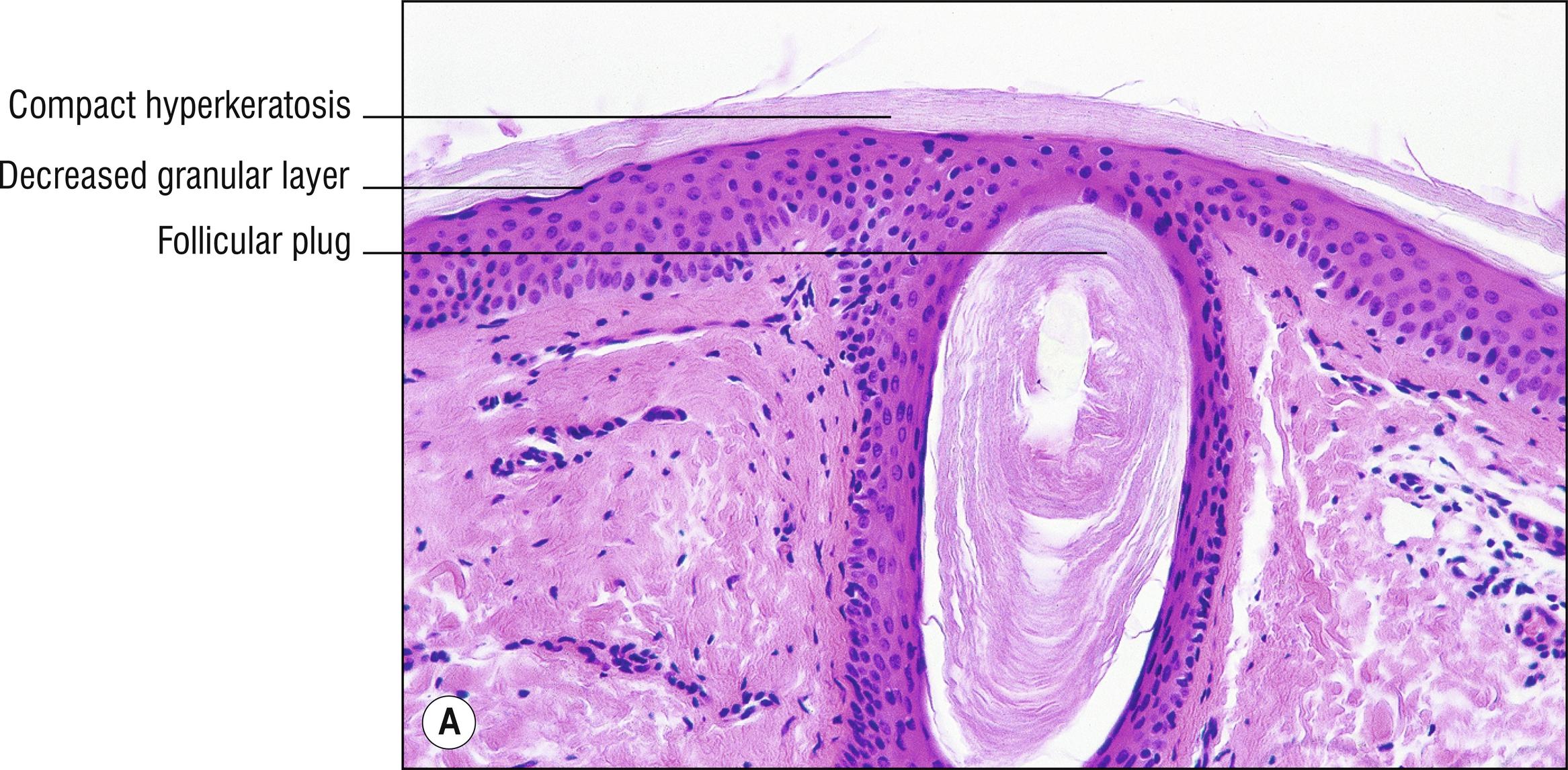
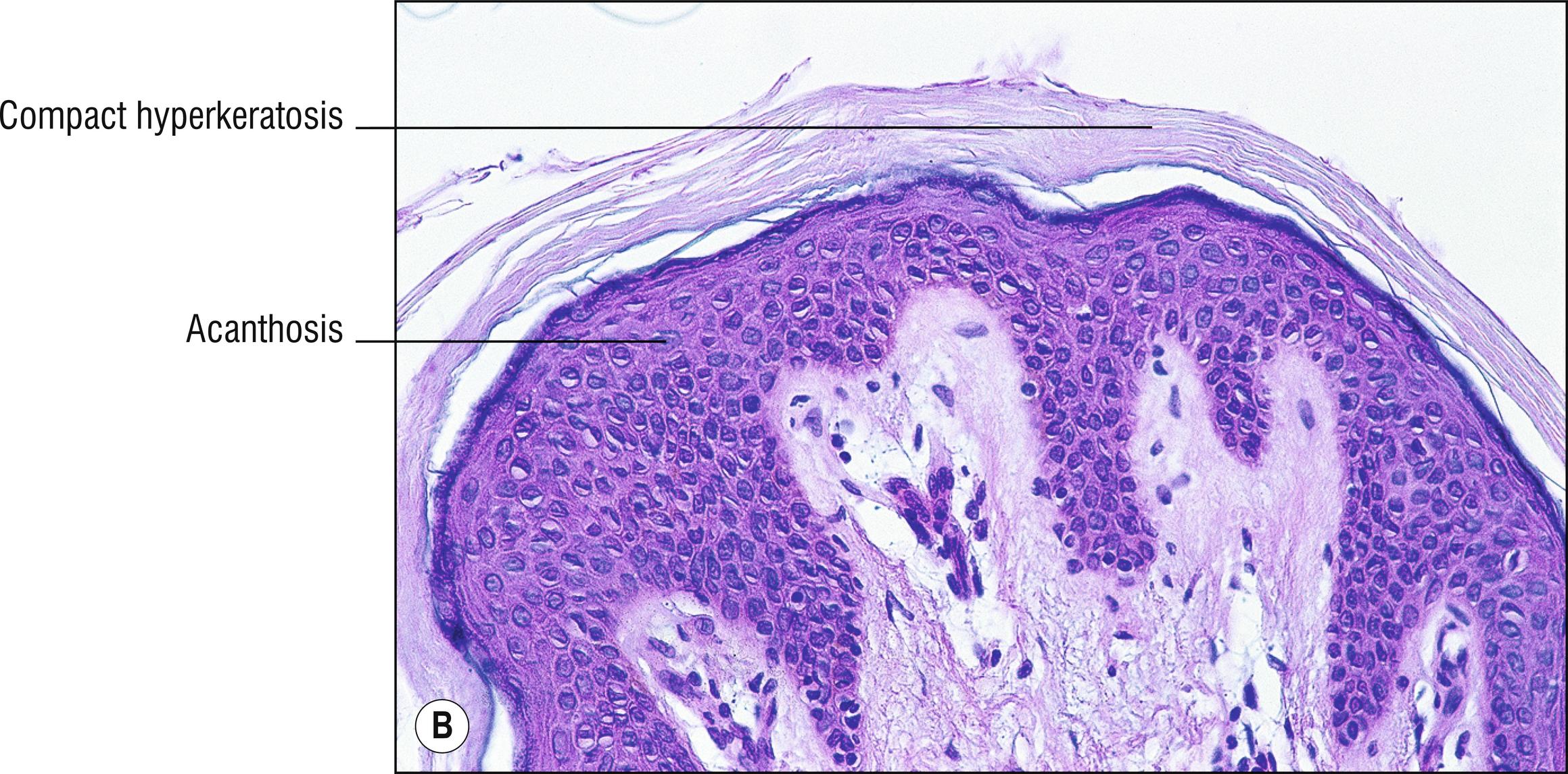
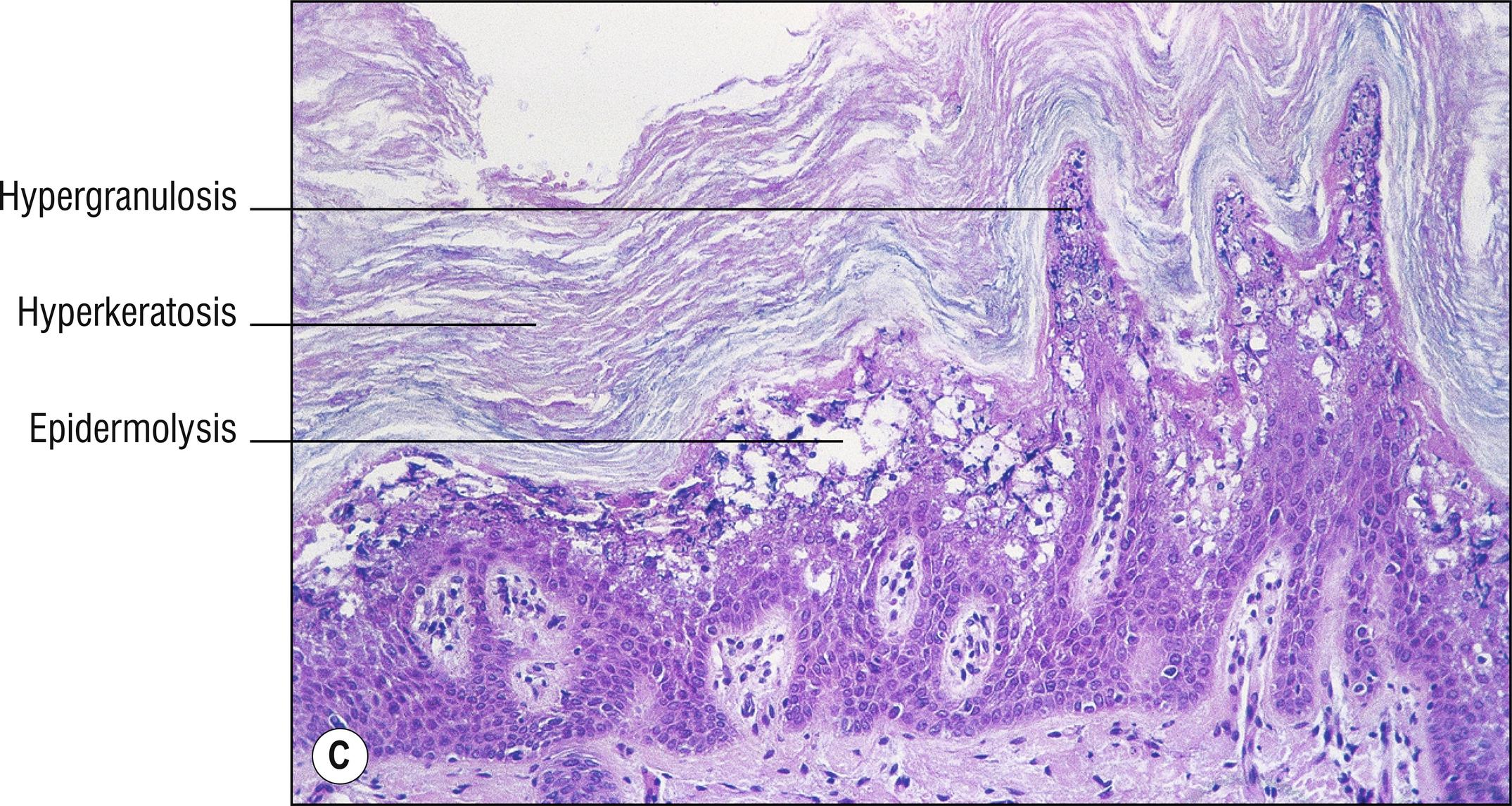
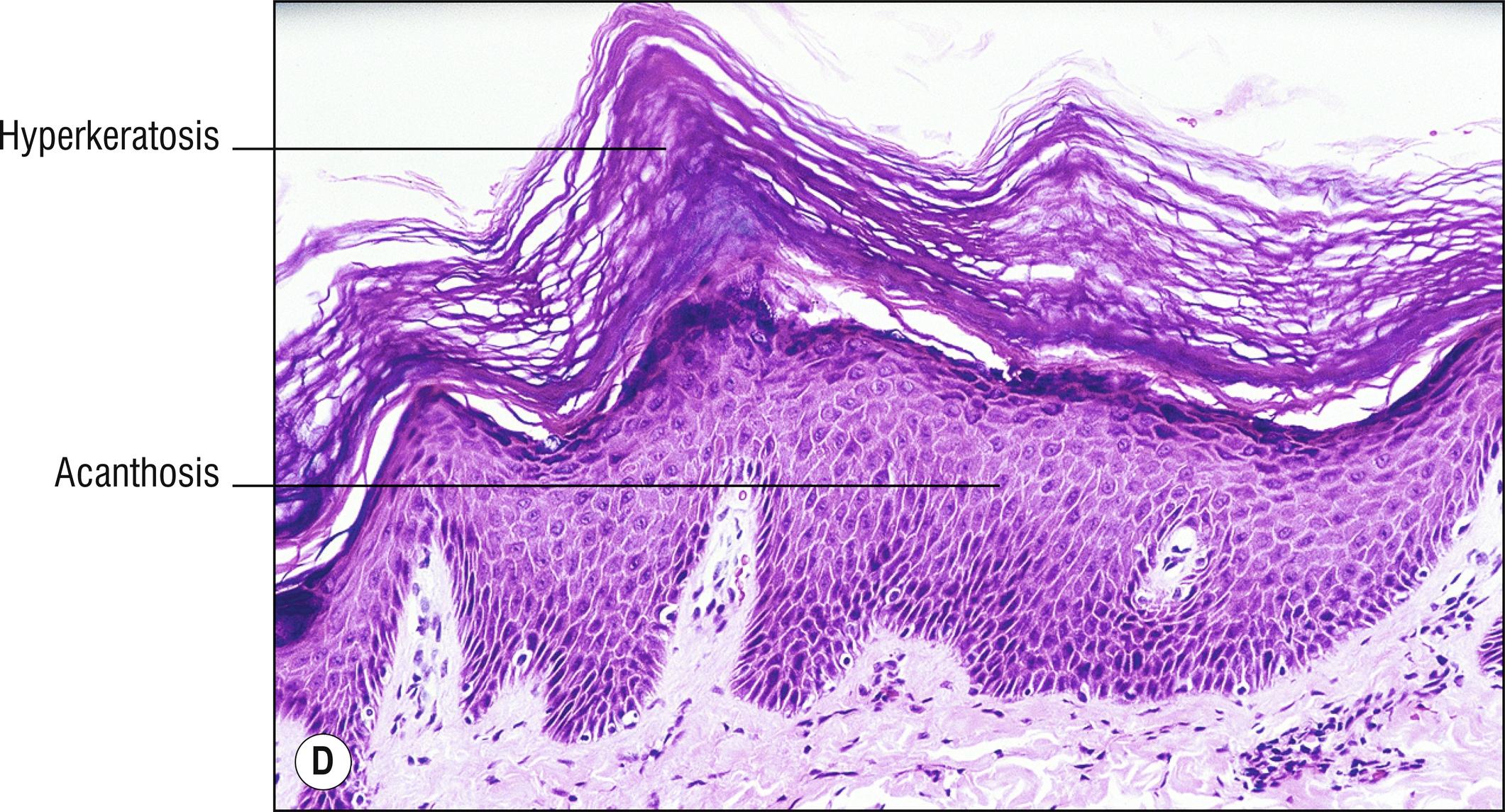
Although ichthyosis (from Greek ichthys, meaning fish skin; “sauriasis,” from Greek sauros meaning lizard skin, like a dinosaur, as opposed to “psoriasis”) has traditionally been divided into four major groups (the first four listed below), this is an oversimplification. Most present as scaly skin (1.29) at birth or early childhood . There are many syndromes associated with ichthyosis. Ichthyosis vulgaris, epidermolytic hyperkeratosis, and Refsum’s disease show distinctive pathology; the others are less specific histologically.
Compact hyperkeratosis (instead of normal “basket-weave”) in most forms of ichthyosis
Normal or thickened granular layer in most variants, except decreased granular layer (hypogranulosis) in ichthyosis vulgaris and acquired ichthyosis
Varying degrees of acanthosis, usually not much parakeratosis
Ichthyosis vulgaris: most common type of ichthyosis, autosomal dominant, with defect in filaggrin synthesis (FLG gene). Milder fine whitish scales begin in childhood, but not usually present at birth, spares antecubital and popliteal flexural areas. Associated with atopic dermatitis (2.1, which tends to involve flexural creases and is more spongiotic without a decreased granular layer) and keratosis pilaris (10.5).
Compact orthokeratosis and acanthosis (1.61)
Decreased or absent granular layer (1.63)
Follicular plugging sometimes (1.47)
Epidermolytic hyperkeratosis (EHK, bullous congenital ichthyosiform erythroderma, BCIE): autosomal dominant, defect in keratin 1 (KRT1) or 10 (KRT10, suprabasal keratins), brownish , verrucous , scaly skin with appearance of furrows and mud on the skin, prominent flexural involvement, vesicles and bullae may occur early in life.
Compact orthokeratosis and acanthosis
Hypergranulosis (1.60)
Distinct type of degeneration of keratinocytes (1.144) called “ epidermolytic hyperkeratosis ” (superficial epidermis degenerated, appearing as if “blown out by a shotgun”)
Sometimes intraepidermal blisters (1.147) in the degenerated areas, early in infancy (not later in life)
X-linked ichthyosis: Second most common ichthyosis, brownish scaly eruption begins in early childhood in males . Associated with steroid sulfatase deficiency (STS gene). More likely to involve the flexural creases than ichthyosis vulgaris, but sometimes flexures are spared. Corneal opacities, cryoptorchidism (20%), increased risk of testicular cancer), hypogonadism.
Lamellar ichthyosis: autosomal recessive (possibly there is a rare autosomal dominant form), severe thick plates of scale resemble reptile scales, onset usually at birth. Variants have been associated with keratinocyte transglutaminase, ABCA12, or CYP4F22 genes. Involves flexures, palms, and soles. May present as a collodion baby. Associated with mutation in keratinocyte transglutaminase. Lamellar ichthyosis has been separated from non-bullous recessive congenital ichthyosiform erythroderma (NCIE), on the basis of the former being less severe, and improving with age, but there may not be overlap between these conditions.
Collodion baby: ichthyosis of the newborn , representing initial presentation of lamellar ichthyosis, or less commonly one of the other forms.
Harlequin fetus: rare, mutation in ABCA12 gene (also causes some forms of lamellar ichthyosis), a more severe form of collodion baby infant born encased in thick horny skin with deep fissures, marked ectropion and eclabium , rudimentary ears , usually fatal , massive compact orthokeratosis, sometimes with parakeratosis, absence of lamellar bodies with electron microscopy.
Conradi–Hunermann syndrome: rare, mutation in gene encoding delta(8)-delta(7) sterol isomerase emopamil-binding protein (EBP), X-linked dominant, linear (1.73) or whorled ichthyosis with hyperpigmentation, cataracts, and skeletal defects such as chondrodysplasia punctata (stippled epiphyses).
Netherton’s syndrome: rare, but one of the more common ichthyotic syndromes, autosomal recessive, mutation in gene encoding serine protease inhibitor Kazal-type 5 (SPINK5), negative immunostaining for LEKTI (lympho-epithelial Kazal-type-related inhibitor), which is commercially available. Failure to thrive in infancy, generalized erythroderma, atopic with high serum IgE, mild alopecia with hair defect (1.4) known as trichorrhexis invaginata ( bamboo hair ). About half of the patients develop a peculiar migratory ichthyosis linearis circumflexa annular (1.5) to serpiginous (1.127), psoriasiform (1.119) plaques, that have double-edged borders described by Comel, so sometimes is called Comel–Netherton syndrome. Biopsy is psoriasiform, with compact parakeratosis, sometimes subcorneal splitting, clear cells in superficial epidermis resembling koilocytes, dyskeratosis. PAS-positive exudative material in the granular layer has been emphasized, but is not so specific.
Erythrokeratodermia variabilis (Mendes da Costa syndrome): rare, autosomal dominant, mutation in genes for gap junction proteins GJB3 (encoding connexin 31) and GJB4 (encoding connexin 30.3), onset within 1 year of age, polycyclic to annular (1.5) migrating red scaly plaques, often palmoplantar keratoderma (2.15).
Refsum’s disease: rare, autosomal recessive, generalized ichthyosis, cerebellar ataxia, peripheral neuropathy, retinitis pigmentosa, and elevated CSF protein without increase in cells. Classic adult form has a mutation in gene encoding phytanoyl-CoA hydroxylase (PHYH, or PAHX), or gene for peroxin-7 (PEX7). Infantile form has mutation in PEX1, PEX2, or PEX 26 genes. Lipid vacuoles in suprabasal cells , phytanic acid accumulation.
Sjögren–Larsson syndrome: rare, mutation in ALDH3A2 gene for fatty aldehyde dehydrogenase, autosomal recessive, seizures, retinitis pigmentosa, lamellar ichthyosis, mental retardation, and spastic paresis .
Keratitis–ichthyosis–deafness (KID) syndrome: rare, sporadic or autosomal dominant, mutation in gap junction protein GJB2 (encoding connexin-26), face, elbows, knees, palm and sole ichthyosis, sparing trunk.
CHILD syndrome (congenital hemidysplasia with ichthyosiform erythroderma and limb defects): rare, probably X-linked, mutation in gene encoding NSDHL, almost always females, unilateral ichthyosis with underdeveloped limbs on same side.
Ichthyosis hystrix: autosomal dominant, form of epidermal nevus with whorling (18.1), may have epidermolytic hyperkeratosis.
Ichthyosis bullosa of Siemens: rare, autosomal dominant, blistering ichthyosis similar to epidermolytic hyperkeratosis, except that hyperkeratosis is mild, the epidermolysis involves mostly the granular layer and is less extensive, and the gene defect is keratin 2e.
Acquired ichthyosis: onset in adulthood, often as a paraneoplastic syndrome (1.105), especially with lymphoma, histology usually like ichthyosis vulgaris.
Pityriasis rotunda: rare, perfectly round , sharply demarcated, scaly plaques, more common in pigmented races, sometimes familial or associated with underlying malignancy, sometimes considered a localized form of ichthyosis vulgaris or acquired ichthyosis.
Other diseases with hyperplasia of epidermis (1.61), especially eczema (2.1).
The histologic finding of epidermolytic hyperkeratosis can be seen in some forms of hyperkeratosis palmaris et plantaris (2.16), some forms of epidermal nevi (18.1), epidermolytic acanthoma, and, occasionally, as an incidental finding in a variety of disorders, especially dysplastic nevi. Normally it is not mistaken for spongiosis (1.132), koilocytosis (14.1), or artifactual vacuolization of keratinocytes (1.144).
Very rare heterogeneous group of more than 150 disorders of skin and its appendages, mainly involving hair , teeth , nails , and sweating . It is a misnomer because the ectoderm is hypoplastic, not dysplastic (if dysplasia is defined as cytologic atypia of epithelium). Traditionally, patients were imperfectly placed into hidrotic and anhidrotic groups.
Decreased number and hypoplasia of sebaceous glands and hair follicles
Decreased number or absent sweat glands in patients with the anhidrotic form
Hidrotic ectodermal dysplasia: autosomal dominant, mutation in GJB6 gene encoding connexin-20, milder disease than anhidrotic, patients retain relatively normal sweating , alopecia (1.4), dystrophic nails (1.85), and palmoplantar keratoderma (2.15), dental defects sometimes.
Anhidrotic (hypohidrotic) ectodermal dysplasia: X-linked recessive, mutation in gene encoding ectodysplasin-A (EDA), mostly males , characteristic facies , with frontal bossing and a depressed nasal bridge, decreased or absent sweating , alopecia (1.4), dystrophic nails (1.85), and marked dental defects.
Schopf syndrome: alopecia, nail dystrophy, teeth defects, eyelid hidrocystomas , basal cell carcinoma, palmoplantar keratoderma associated with syringofibroadenomatosis (23.10). WNT10A gene mutation.
Ectodermal dysplasia is primarily a clinical diagnosis, and biopsies of palms or soles are mainly helpful by showing absent sweat glands in the anhidrotic form, or associated findings such as syringofibroadenomatosis.
(see Fig. 11.3A–C )
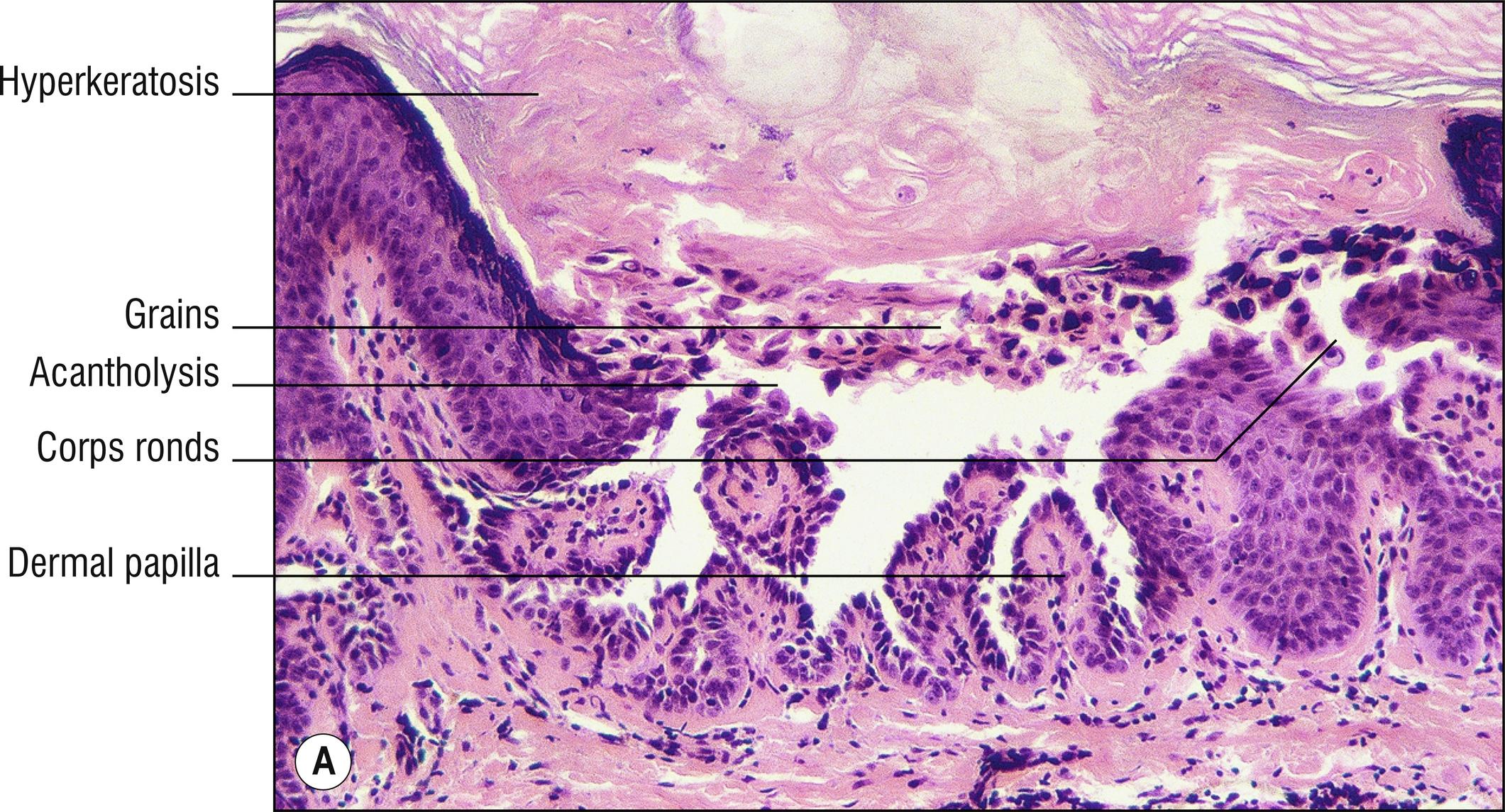
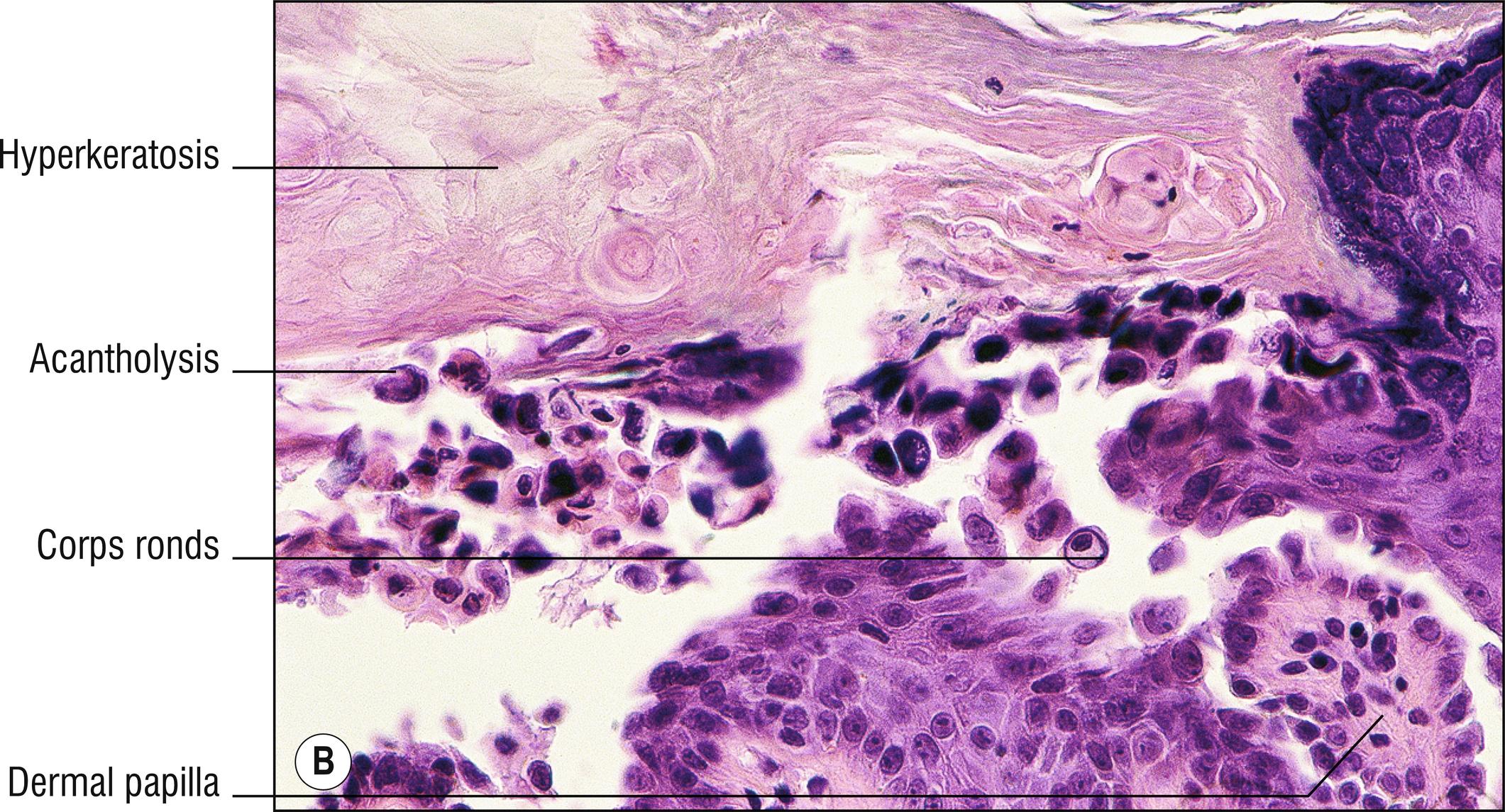
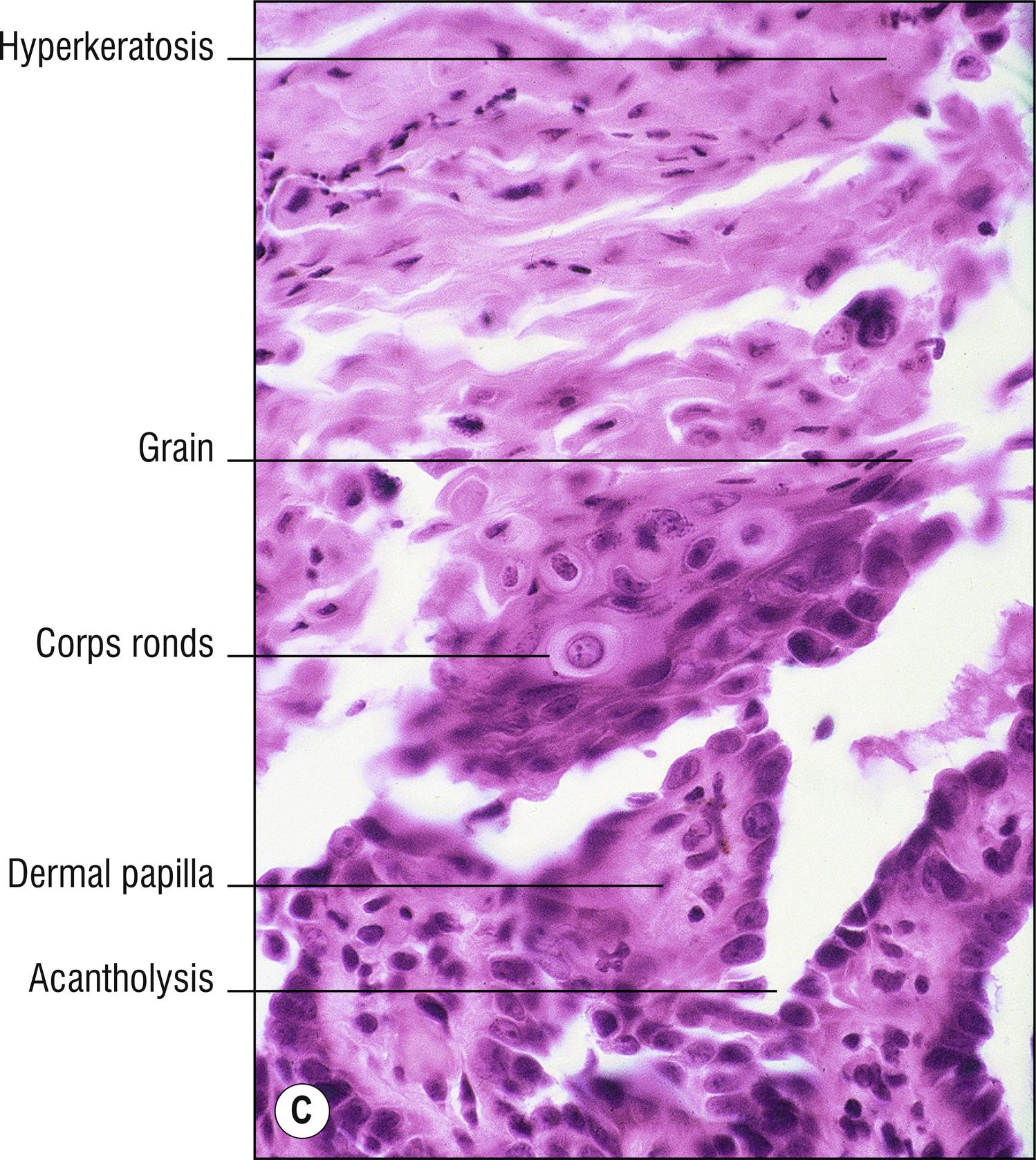
Uncommon autosomal dominant disorder, related to calcium pump protein mutation ATP2A2 (compare with Hailey–Hailey disease, ATP2C1), with ground nutmeg dirty verrucous appearance of skin of the trunk (1.141), and sometimes the face, flaring with sun or heat exposure (1.110), palmar pits (1.100), nails with longitudinal ridges and triangular distal defects (1.85), white plaques in the mouth (1.82). Acrokeratosis verruciformis may occur (18.3) on the dorsum of hands and feet.
Hyperkeratosis , parakeratosis sometimes, pseudoepitheliomatous hyperplasia sometimes (1.116), basaloid hyperplasia sometimes. “Follicularis” is partially a misnomer because the hyperkeratosis is not preferentially over follicles, but sometimes follicular plugging is indeed present (1.47)
Papillomatosis and acanthosis
Acantholytic dyskeratotic keratinocytes , often forming “ corps ronds ” and “grains” (1.27)
Clefts (1.23) or lacunae forming in suprabasal location due to acantholysis; dermal papillae lined by basal cells stick up into the lacunae, resembling villi . Rarely this can appear clinically vesiculobullous (1.147)
Other diseases with acantholysis (1.2), especially those that also show dyskeratosis: transient acantholytic dermatosis (TAD, 5.2), warty dyskeratoma (18.7), and sometimes Hailey–Hailey disease (5.5). TAD can be identical histologically and sometimes must be distinguished clinically. Pemphigus (5.4) is usually not dyskeratotic, without corps ronds, and tends to have eosinophils. Linear epidermal nevus (18.1) may have acantholytic dyskeratosis, and some forms of this have been called localized, linear, or zosteriform Darier’s disease. The rare familial dyskeratotic comedones has a clinically comedonal appearance with acantholysis at the base of the comedones.
Very rare disease with shortened telomeres. The X-linked recessive disorder (mostly in males) is often due to mutation in gene encoding dyskerin (DKC1). There is an autosomal dominant form related to mutation in the gene encoding telomerase RNA component (TERC). There is a recessive form due to mutation in NOLA3 (NOP10), or NOLA2 (NHP2). Several other gene defects have been described, suggesting it is a heterogeneous condition.There is a classic triad of hyperpigmentation (1.18), oral leukoplakia (1.82), and dystrophic nails (1.85). The pigmentation can be reticulated (1.123), poikilodermatous (1.112), or grayish (1.54), often on the neck (1.86), thighs, and trunk.Cutaneous squamous cell carcinomas can arise at a young age, and the leukoplakia may also become carcinoma. Aplastic anemia occurs in up to 80% of patients. Also common is pulmonary fibrosis (20%) and internal malignancies (1.105).
Epidermis normal or atrophic (1.9)
Melanin incontinence
Absent or minimal interface lymphocytes (1.64)
The pathology is nonspecific, and the diagnosis is primarily made clinically and by genetic testing. Consider other disorders with melanin incontinence (1.79).
Become a Clinical Tree membership for Full access and enjoy Unlimited articles
If you are a member. Log in here